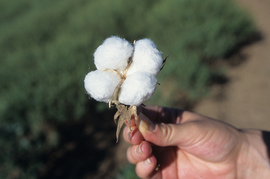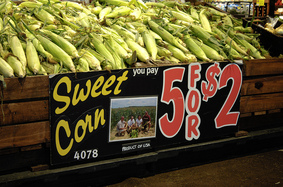|
Having trouble viewing this email? View it as a Web page.

|
|
|
Fresh from the Field is a weekly album showcasing transformative impacts made by grantees supported by the National Institute of Food and Agriculture.
Oct. 26, 2017
|
|
Success Stories

Mixing Reverses Pest Resistance to Biotech Cotton
Researchers at University of Arizona (UA) and Beijing’s Institute of Plant Protection
discovered an unexpected strategy that can delay, and even reverse, the
evolution of resistance by pests to genetically engineered crops. A new
study reveals the success of hybridizing genetically engineered cotton with
conventional cotton to reduce resistance in the pink bollworm, a voracious
global pest.
Cotton,
corn, and soybean have been genetically engineered to produce pest-killing
proteins from the widespread soil bacterium Bacillus
thuringiensis, or Bt. These Bt proteins are considered environmentally
friendly because they are not toxic to people and wildlife. They have been used
in sprays by organic growers for more than 50 years, and by millions of farmers
worldwide in engineered Bt crops planted on more than 1 billion acres since
1996. Unfortunately, without adequate countermeasures, pests can quickly evolve
resistance.
The
ingenious strategy used in China entails interbreeding Bt cotton with non-Bt
cotton, then crossing the resulting first-generation hybrid offspring and
planting the second-generation hybrid seeds. This generates a random mixture
within fields of 75 percent Bt cotton plants side-by-side with 25 percent
non-Bt cotton plants.
"Because
cotton can self-pollinate, the first-generation hybrids must be created by
tedious and costly hand pollination of each flower. However, hybrids of
the second generation and all subsequent generations can be obtained readily
via self-pollination. So, the hybrid mix and its benefits can be maintained in
perpetuity," said Bruce Tabashnik, researcher at UA.
NIFA
supports the research through the Biotechnology Risk
Assessment Grant Program.
Read
the full story at UANews. USDA
photo by Larry Rana.
|
 Climate Smart Weather Tools
Researchers
at the University of Florida are helping state growers save millions of
dollars via the Florida Automated Weather Network (FAWN), a tool to gauge
weather in agricultural areas.
According
to Director Rick Lesher, FAWN provides agriculture weather-related
data in areas that are not served by the National Weather Service tools located
at airports. FAWN allows farmers to monitor evaporation levels, which indicates
when they should turn off their irrigation systems.
Farmers
are saving up to two hours of irrigation daily.
“You
can’t be everywhere at once, but FAWN gives us a lead on how to better manage
our crops,” said James Shinn, who has citrus and peach groves in Lake Alfred
and Vero Beach. “FAWN gives us real-life data on different sites throughout the
state. I can’t tell you how beneficial this has been to our industry.”
NIFA
supports the work through the Smith-Lever Act Capacity
Grant.
Read
the full story at Land-Grant Impacts. USDA
photo by Larry Rana.
|
News Coverage

New Beginnings for Future Farmers
Researchers
at the University of New Hampshire (UNH) are working to increase local
agriculture and expand local food production to support industry and provide
jobs to rural America.
Local
agriculture is a growing industry in northern New England, with the help of legislation
in Maine, Vermont, and New Hampshire. To help these efforts, UNH conducted a
regional survey about consumer values and perspectives pertaining to local
foods and agriculture.
Researchers
found that 54 percent of those surveyed said it was “very important” that any
type of fresh produce be grown on local farmland. Other factors considered
“very important” to consumers included supporting the local economy (46
percent) and buying produce that is grown without pesticides (45 percent).
Read
the full article at UNH.
NIFA supports the research through the Hatch Act and the Agriculture and Food Research Initiative. Image provided by UNH.
|
The Library

Sweet Corn May Improve Animal Vaccines
Adjuvants are compounds added to animal vaccines to help
stimulate the immune system, boosting their effectiveness. Many aluminum-based nonbiodegradable adjuvants may cause inflammation at the vaccine site that may persist for months and diminish the quality of livestock meat in food animal.
Researchers at Purdue University in Indiana discovered
another possible adjuvant in teeny, tiny nanoparticles derived from a variety
of sweet corn. They found that the new adjuvant stimulates the immune response
and has a much briefer period of inflammation that eventually disappears. The
new nanoparticle-based adjuvant is biodegradable and inexpensive.
NIFA supports the research through the Hatch Act.
Read more at Nature. USDA photo by Bob Nichols.
|
Video

Youth from across Minnesota participated in a four-day 4-H Campus
Immersion camp that provided fun challenges and hands-on STEM activities. The
experience stretched the teen participants’ views of themselves and college
life.
"The purpose is to immerse youth in the college experience
and to help them take steps that prepare them to go to college when the time is
right," said Jennifer Skuza, assistant dean for Extension 4-H youth
development at the University of Minnesota. "The program also helps plants
seeds for future college success."
Youth from counties and tribes across Minnesota found it easier to
imagine themselves in college by experiencing campus life. "The (University
of Minnesota) is different than most college campuses because there's such
variety,” said Perry, a 14-year-old Ojibwe member of the Fond du Lac Band of
Lake Superior Chippewa, whose goal is to study plant science. “It's been fun to
stay in the dorms like a college student."
This experience is part of University of Minnesota Extension’s
effort to introduce more youth and families to 4-H, including those who are
often underserved in youth development opportunities.
NIFA supports this program with the Children, Youth and Families at Risk (CYFAR) Program.
Watch the 4-H Campus Immersion video. Image provided by University of Minnesota 4-H.
|
Tweet of the Week
#NIFAIMPACTS
|
|

NIFA’s mission is to invest in and advance agricultural research, education, and extension that solve societal challenges. NIFA’s investments in transformative science directly support the long-term prosperity and global preeminence of U.S. agriculture. To learn more about NIFA’s impact on agricultural sciences, visit www.nifa.usda.gov/Impacts, sign up for email updates or follow us on Twitter @USDA_NIFA, #NIFAImpacts.
Editor: Falita Liles
USDA is an equal opportunity lender, provider, and employer.
|
|